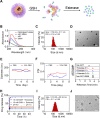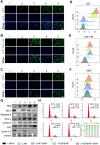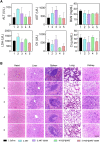Synergetic delivery of artesunate and isosorbide 5-mononitrate with reduction-sensitive polymer nanoparticles for ovarian cancer chemotherapy
- PMID: 36335352
- PMCID: PMC9636721
- DOI: 10.1186/s12951-022-01676-3
Synergetic delivery of artesunate and isosorbide 5-mononitrate with reduction-sensitive polymer nanoparticles for ovarian cancer chemotherapy
Abstract
Ovarian cancer is a highly fatal gynecologic malignancy worldwide. Chemotherapy remains the primary modality both for primary and maintenance treatments of ovarian cancer. However, the progress in developing chemotherapeutic agents for ovarian cancer has been slow in the past 20 years. Thus, new and effective chemotherapeutic drugs are urgently needed for ovarian cancer treatment. A reduction-responsive synergetic delivery strategy (PSSP@ART-ISMN) with co-delivery of artesunate and isosorbide 5-mononitrate was investigated in this research study. PSSP@ART-ISMN had various effects on tumor cells, such as (i) inducing the production of reactive oxygen species (ROS), which contributes to mitochondrial damage; (ii) providing nitric oxide and ROS for the tumor cells, which further react to generate highly toxic reactive nitrogen species (RNS) and cause DNA damage; and (iii) arresting cell cycle at the G0/G1 phase and inducing apoptosis. PSSP@ART-ISMN also demonstrated excellent antitumor activity with good biocompatibility in vivo. Taken together, the results of this work provide a potential delivery strategy for chemotherapy in ovarian cancer.
Keywords: Artesunate; Cell cycle arrest; DNA damage; Isosorbide 5-mononitrate; Mitochondrial damage; Ovarian cancer.
© 2022. The Author(s).
Conflict of interest statement
The authors declare no competing financial interests.
Figures





Similar articles
-
Inhibition of angiogenesis, tumour growth and metastasis by the NO-releasing vasodilators, isosorbide mononitrate and dinitrate.Br J Pharmacol. 1995 Sep;116(2):1829-34. doi: 10.1111/j.1476-5381.1995.tb16670.x. Br J Pharmacol. 1995. PMID: 8528567 Free PMC article.
-
Contribution of reactive oxygen species to ovarian cancer cell growth arrest and killing by the anti-malarial drug artesunate.Mol Carcinog. 2017 Jan;56(1):75-93. doi: 10.1002/mc.22474. Epub 2016 Feb 15. Mol Carcinog. 2017. PMID: 26878598
-
Absorption and excretion of isosorbide dinitrate and isosorbide-2-mononitrate in dogs.J Pharm Pharmacol. 1983 May;35(5):312-6. doi: 10.1111/j.2042-7158.1983.tb02940.x. J Pharm Pharmacol. 1983. PMID: 6134800
-
Isosorbide mononitrate 30% immediate-release 70% sustained-release formulation: a review. DUMQOL (DUtch Mononitrate Quality of Life) Study Group.Angiology. 2000 Aug;51(8):631-8. Angiology. 2000. PMID: 10959515 Review.
-
Long-acting isosorbide mononitrate.Drugs. 1999 Jan;57(1):93-9; discussion 100. doi: 10.2165/00003495-199957010-00008. Drugs. 1999. PMID: 9951954 Review.
Cited by
-
Polymer Nanoparticles Advancements for Gynecological Cancers.Int J Nanomedicine. 2025 May 26;20:6721-6742. doi: 10.2147/IJN.S527023. eCollection 2025. Int J Nanomedicine. 2025. PMID: 40452785 Free PMC article. Review.
-
Synergistic Neuroprotection of Artesunate and Tetramethylpyrazine in Ischemic Stroke, Mechanisms of Blood-Brain Barrier Preservation.Int J Mol Sci. 2025 Aug 18;26(16):7979. doi: 10.3390/ijms26167979. Int J Mol Sci. 2025. PMID: 40869300 Free PMC article.
-
In Vitro Drug Repurposing: Focus on Vasodilators.Cells. 2023 Feb 20;12(4):671. doi: 10.3390/cells12040671. Cells. 2023. PMID: 36831338 Free PMC article. Review.
-
Highly Efficient Synergistic Chemotherapy and Magnetic Resonance Imaging for Targeted Ovarian Cancer Therapy Using Hyaluronic Acid-Coated Coordination Polymer Nanoparticles.Adv Sci (Weinh). 2024 Nov;11(41):e2309464. doi: 10.1002/advs.202309464. Epub 2024 Sep 17. Adv Sci (Weinh). 2024. PMID: 39287149 Free PMC article.
-
Artesunate: A Review of Its Potential Therapeutic Effects and Mechanisms in Digestive Diseases.Pharmaceutics. 2025 Feb 25;17(3):299. doi: 10.3390/pharmaceutics17030299. Pharmaceutics. 2025. PMID: 40142963 Free PMC article. Review.
References
-
- Siegel RL, Miller KD, Jemal A. Cancer statistics, 2020. CA Cancer J Clin. 2020;70:7–30. - PubMed
MeSH terms
Substances
Grants and funding
LinkOut - more resources
Full Text Sources
Medical
Miscellaneous

